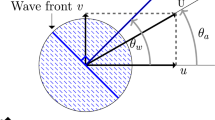Abstract
Starting from nonhydrostatic Boussinesq approximation equations, a general method is introduced to deduce the dispersion relationships. A comparative investigation is performed on inertia-gravity wave with horizontal lengths of 100, 10 and 1 km. These are examined using the second-order central difference scheme and the fourth-order compact difference scheme on vertical grids that are currently available from the perspectives of frequency, horizontal and vertical component of group velocity. These findings are compared to analytical solutions. The obtained results suggest that whether for the second-order central difference scheme or for the fourth-order compact difference scheme, Charny–Phillips and Lorenz (L) grids are suitable for studying waves at the above-mentioned horizontal scales; the Lorenz time-staggered and Charny–Phillips time staggered (CPTS) grids are applicable only to the horizontal scales of less than 10 km, and N grid (unstaggered grid) is unsuitable for simulating waves at any horizontal scale. Furthermore, by using fourth-order compact difference scheme with higher difference precision, the errors of frequency and group velocity in horizontal and vertical directions produced on all vertical grids in describing the waves with horizontal lengths of 1, 10 and 100 km cannot inevitably be decreased. So in developing a numerical model, the higher-order finite difference scheme, like fourth-order compact difference scheme, should be avoided as much as possible, typically on L and CPTS grids, since it will not only take many efforts to design program but also make the calculated group velocity in horizontal and vertical directions even worse in accuracy.
Similar content being viewed by others
References
Arakawa, A., Lamb, V.R.: Computational design of the basic dynamical processes of the UCLA general circulation model. Methods Comput. Phys. 17, 174 –264 (1976)
Charney, J.C., Phillips, N.A.: Numerical integration of the quasi-geostrophic equation for barotropic and simple baroclinic flows. J. Meteorol. 10, 17–29 (1953)
Fox Rabinovitz, M.S.: Computational dispersion properties of verticallly staggered grids for atmospheric models. Mon. Weather Rev. 122, 377–392 (1994)
Fox Rabinovitz, M.S.: Computational dispersion properties of 3D staggered grids for a nonhydrostatic anelastic system. Mon. Weather Rev. 124, 498–510 (1996)
Lele, S.K.: Compact finite difference schemes with spectral-like resolution. J. Comput. Phys. 103, 16–42 (1992)
Lorenz, E.N.: Energy and numerical weather prediction. Tellus 12, 364–373 (1960)
Tokioka, T.: Some considerations on vertical differencing. J. Meteorol. Soc. Jpn. 56, 98–111 (1978)
Author information
Authors and Affiliations
Corresponding author
Rights and permissions
About this article
Cite this article
Liu, Y. Impact of difference accuracy on computational properties of vertical grids for a nonhydrostatic model. Comput Geosci 12, 245–253 (2008). https://doi.org/10.1007/s10596-008-9081-2
Received:
Accepted:
Published:
Issue Date:
DOI: https://doi.org/10.1007/s10596-008-9081-2




